Elsevier Encyclopedia of Geology - vol I A-E
Подождите немного. Документ загружается.


Thrust Faults
Geologists in the nineteenth century were puzzled
when they saw older rocks lying on top of younger
rocks. One of the classic locations where this is
readily observed is in eastern Switzerland (Figure 5).
The rugged peaks of the Tschingelhore are formed
by Permian clastic sediments (roughly 260 Ma), but
the rock immediately beneath the peaks consists of
Jurassic limestones (formed about 150 Ma). The
famous Glarus thrust is the sharp contact between
the close proximity of the Permian and Jurassic
units. The geographical extension of the Glarus thrust
can be seen in a profile across eastern Switzerland
(Figure 6). The Helvetic nappes were displaced north-
ward along the Glarus thrust over a distance of
50 km. In order to displace a thrust sheet, a weak,
basal lubricating layer must be present. In the case of
the Glarus thrust, this lubricating layer is a highly
sheared limestone, which was scraped off the foot-
wall and dragged and drawn out along the thrust
surface. It now forms a layer roughly 1 m thick and
can be traced northward over a distance of some
30 km (in Figure 5 it is visible as a thin, light line
along the horizontal contact).
As is evident from Figure 6, substantial internal
deformation affected the rocks below and above the
Glarus thrust. Highly sheared folds and thrust faults,
repeating the various sedimentary layers many times,
can be observed in the Mesozoic sediments beneath
the Glarus thrust. Similarly, the rocks of the displaced
block above the Glarus thrust show thrust faults and
folds. One of these thrust faults, the Sa
¨
ntis thrust,
displaced the younger Cretaceous strata much further
north, compared to the older (Triassic to Jurassic)
strata. In this case, the thrust fault was lubricated by
a thick layer of shales, which have relatively low shear
resistance.
Nappe Internal Deformation
As a thrust sheet is compressed, detached from its
substrate, and transported, it undergoes internal de-
formation. The type of deformation depends largely
on the nature of the rocks involved. In the case of a
layered sequence of sedimentary rocks, folding pre-
vails, whereas if the mechanical contrasts are low,
such as sometimes occurs in a suite of granitic and
gneissic rocks, the deformation may be more homo-
geneous. If mechanically weak layers of rocks are
present, the deformation is focused and thrust
faults may develop. All of these processes – folding,
faulting, and homogeneous deformation – may take
place jointly.
Figure 7 shows folded Cretaceous and Eocene lime-
stones (100 to 50 Ma) that form an asymmetric anti-
cline. The folded limestones are overlain by older
rocks. Dolomites (220 Ma) form the yellow cliff
beneath the summit and crystalline basement rocks
(>300 Ma) make up the dark summit. These older
Figure 5 The Glarus thrust in the Tschingelhore (between Flims and Elm in eastern Switzerland). The thrust fault is visible as a
sharp horizontal contact between the older rocks that form the rugged peaks and the younger rocks that form the cliffs above the
snowfields.
130 EUROPE/The Alps

rocks were emplaced along a thrust fault that is lo-
cated near the base of the yellow cliff. Figure 8 is a
profile across the Tauern window, where the upper
crust of the European margin forms a large anticlinal
fold. In the centre of the upwarp, erosion has re-
moved the higher nappes, thus providing an insight
into the formerly deeper parts of the orogen. The
crystalline basement rocks in the core of the upwarp
were compressed and internally shortened. From the
deformed mineral grains of the rocks it is possible to
determine how much horizontal shortening and ver-
tical stretching actually occurred and to reconstruct
the shape of the upwarp prior to this homogeneous
deformation. The present-day shape of the Tauern
upwarp (Figure 6), as well as its reconstructed geom-
etry prior to homogeneous shortening, provide a
Figure 6 Profile through the Helvetic nappes of the eastern Swiss Alps. The Helvetic nappes were displaced along the Glarus thrust
over a distance of around 50 km. But the rocks above and below the Glarus thrust were also intricately deformed, as is evident from the
fold-and-thrust structures. The Sa
¨
ntis thrust displaced the uppermost part, the Cretaceous strata, of the Helvetic nappes an additional
10 km to the north. Deeper down, the crystalline basement rocks of the Aar massif now form an anticlinal upwarp. NHF, North Helvetic
Flysch.
Figure 7 Folded strata in the flank of Piz d’Artgas (‘peak with arcs’), overthrust by older rocks forming the summit and the yellow cliff
beneath.
EUROPE/The Alps 131
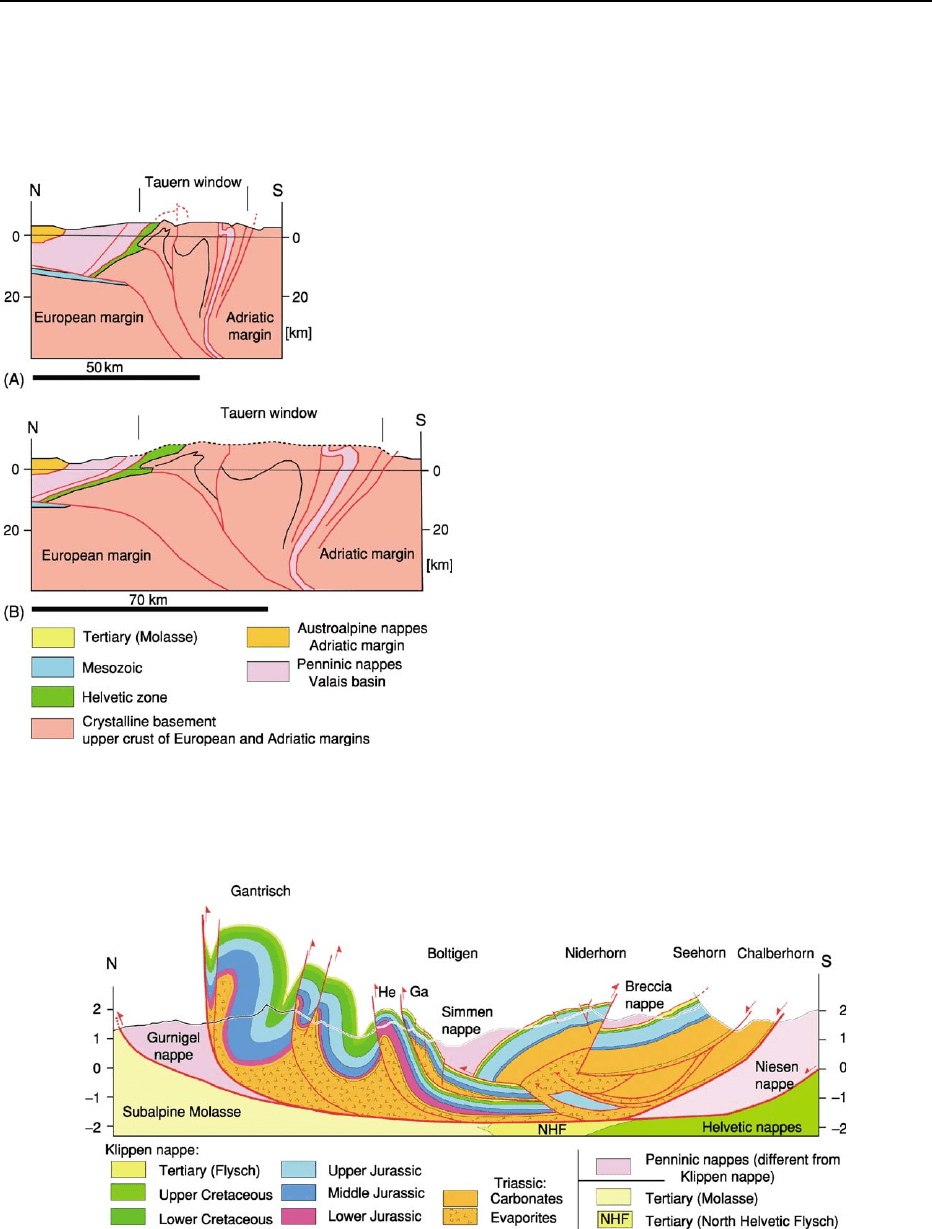
reminder of the ductile behavior that granitic rocks
can exhibit in the course of plate collision.
The Klippen nappe, a Penninic nappe in the
French–Swiss Alps, is a classic example of a style
of internal deformation characterized by fold-and-
thrust structures (Figure 9). The lubricating layer
(evaporites) at the base of the nappe consists of a
thick layer of anhydrite. This rock type, which has a
particularly low shear strength, forms when very
shallow areas of seawater evaporate. The great thick-
ness of the weak evaporite layer in the northern part
of the section shown in Figure 9 facilitated the forma-
tion of large-scale folds, and the anhydrite was able
to flow into and fill the fold cores. In the southern
part of the nappe, the anhydrite layer is thinner and
the deformation style is characterized by imbricate
thrusting. Each thrust fault is parallel to the strata
and followed the weak anhydrite layer.
The Making of the Alps
Geologists working in the Alps had recognized early
on that oceanic sediments occurred within the moun-
tain range and were juxtaposed with rock units typ-
ical for continents. The pyramid of the Matterhorn
(Figure 10), for example, is composed of crystalline
basement rocks that were formed more than 300 Ma
and which originated in the former (Adriatic) margin
of the continental African Plate. In contrast, the base
of the pyramid consists of volcanic and sedimentary
rocks that formed in an ocean basin (the Piemont
Ocean) 170 to 100 Ma ago. The Piemont Ocean
formed in response to divergent motion between the
Eurasian and African plates (see Figure 3). The Alpine
Orogen evolved in a number of steps associated
with relative movements between the Eurasian and
African plates. The ocean basins between the two
continental plates were closed in the process. The
Figure 8 Profile across the Tauern window (Eastern Alps).
(A) Present-day geometry; (B) retrodeformed to the configuration
that existed prior to homogeneous horizontal shortening and
vertical stretching.
Figure 9 Profile across the Penninic Klippen nappe of the western Swiss Alps. The Klippen nappe consists of sediments of the
former Brianc¸ onnais swell that have been overthrust onto sediments scraped off of the Valais basin and the Piemont ocean (the Niesen
and Gurnigel nappes, respectively). The nappe internal structure of the frontal north-west part of the Klippen nappe is dominated by
folding, whereas in the internal south-east part, imbrications stemming from thrust faulting prevail. Ga: Gastlosen thrust, He: Heiti
thrust.
132 EUROPE/The Alps
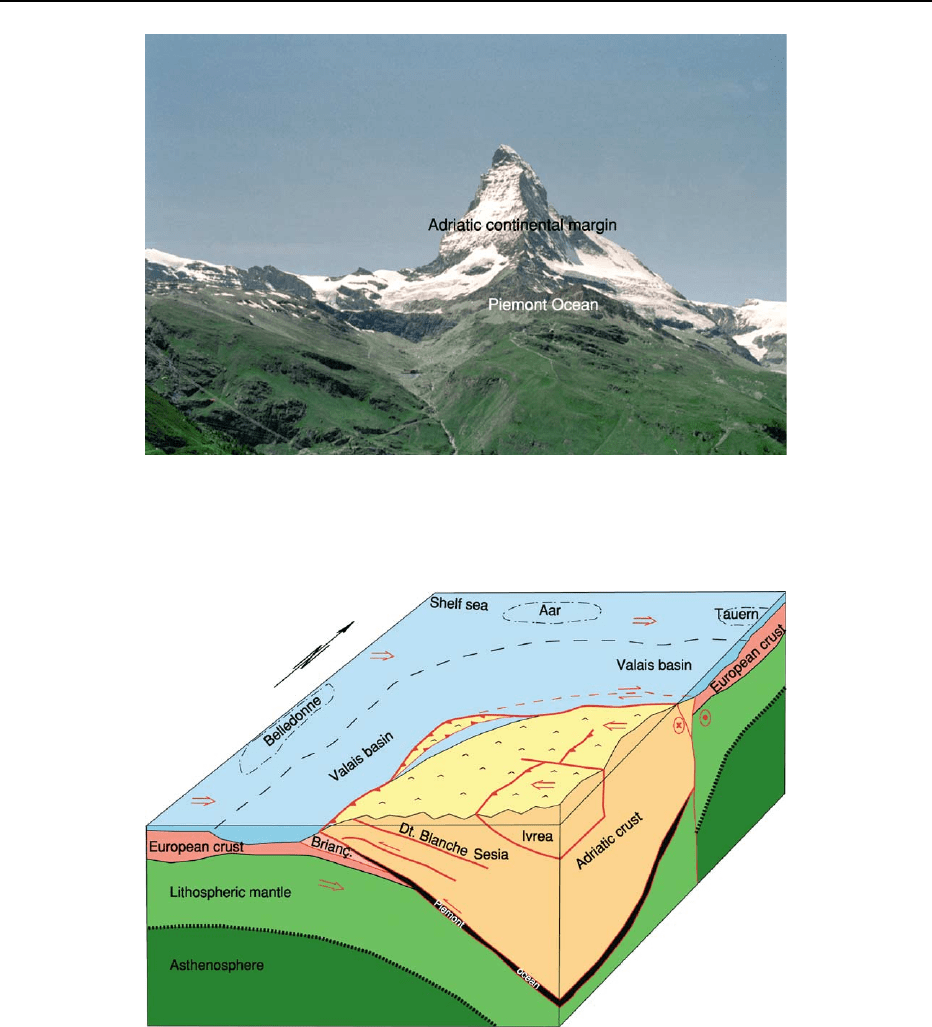
first basin, the Piemont Ocean, closed in Cretaceous
times (100 Ma). The second basin, the Valais,
closed in Tertiary times (35 Ma). Closure of these
basins resulted not only from head-on collision, but
also involved strike–slip movements between the
European and Adriatic margins.
During Cretaceous times, convergence between the
Eurasian and African plates was directed east and
west. The European margin (Figure 11) was ap-
proaching the Adriatic margin, which had already
formed an ancestral mountain range. The Piemont
Ocean had already been subducted along an east-
dipping subduction zone. Small fragments of this
ocean were scraped off of the descending plate and
were attached to the upper plate, a process called
‘underplating’. The Brianc¸onnais microcontinent
Figure 10 Crystalline basement rocks pertaining to the margin of the African continent build up the Matterhorn peak and overlie the
younger volcanic and sedimentary rocks that formed in the Piemont Ocean.
Figure 11 Block diagram showing the three-dimensional geometry of the ancestral Alps at 90 Ma. An east-dipping subduction zone
in the Western Alps had consumed the Piemont Ocean. The Brianc¸ onnais continental fragment was entering this subduction zone. The
Valais basin and the shelf seas of the European margin were the site of ongoing sedimentation.
EUROPE/The Alps 133
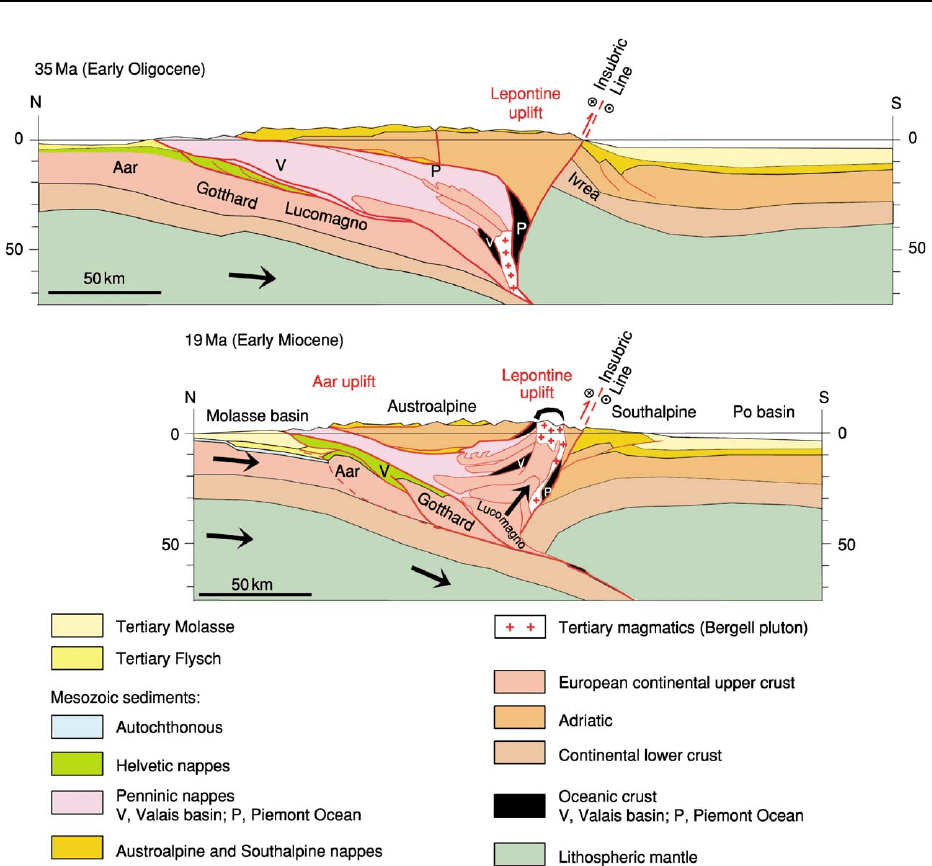
was just in the process of being subducted, but parts
of it were also attached to the upper plate. The Valais
basin was still the site of sedimentation, as was the
shelf of the European margin. In the region of the
future Central and Eastern Alps, the east–west
convergence was expressed as east–west dextral
strike–slip movements. At about 40 Ma, the conver-
gence between the Eurasian and African plates changed
to a north–south orientation. As a consequence, a
south-dipping subduction zone evolved, into which
the Valais basin gradually disappeared. Again, a
number of fragments were scraped off of the descend-
ing plate and were accreted to the upper plate. About
35 Ma, the two margins started to collide. During this
north–south convergence, strike–slip movements took
place in the ancestral Western Alps. In the Central and
Eastern Alps, the collision phase compressed the two
margins and led to the stacking of crustal pieces, hori-
zontal shortening, and vertical stretching. Figure 12
shows two stages of this collision phase in a cross-
section trough the Central Alps, reconstructed for 35
and 19 Ma. The deformation of the two continental
margins pushed crustal fragments up inclined thrust
faults and uplifted parts of the orogen by large-scale
folding and vertical stretching. As a consequence, the
land surface of the ancestral Alps was uplifted. The
ensuing high elevations caused precipitation and
triggered enhanced erosion. Rivers built large fan deltas
in the foreland of the Alps. As far as known, denudation
kept pace with uplift during mountain building.
Nevertheless, deep crustal fragments were exposed
in the process, bringing to the surface samples of rock
Figure 12 North–south profile through the Central Alps of eastern Switzerland, reconstructed to the geometry at 32 and 19 Ma.
Comparison of the two profiles reveals that the orogen grew outward with time on both sides, and that the units in the central part of the
orogen were raised to a higher level by the combined action of folding and erosional denudation.
134 EUROPE/The Alps

that had been at depths of several tens of kilometres
during the early stages of the formation of the Alps.
See Also
Europe: Mediterranean Tectonics; Variscan Orogeny;
Permian to Recent Evolution. Moho Discontinuity.
Further Reading
Debelmas J (1974) Ge
´
ologie de la France. Paris: Doin.
Debelmas J (1979) De
´
couverte Ge
´
ologique des Alpes du
Nord. Orleans: BRGM.
Debelmas J (1982) De
´
couverte Ge
´
ologique des Alpes du
Sud. Orleans: BRGM.
Krenmayr HG (ed.) (2000) Rocky Austria: A Brief Earth
History of Austria. Wien: Geological Survey of Austria.
Labhart TP (2001) Geologie der Schweiz, 5th edn. Thun:
Ott Verlag.
Labhart TP and Decrouez D (1997) Ge
´
ologie de la Suisse.
Lausanne: Delachaux et Niestle
´
.
Lemoine M, deGraciansky P-C, and Tricart P (2000) De
l’Oce
´
an a
`
la Chaı
ˆ
ne de Montagnes: Tectonique des
Plaques dans les Alpes. New York: Gordon & Breach.
Marthaler M (2001) Le Cervin est-il Africain? Lausanne:
Loisir et Pe
´
dagogie.
Marthaler M (2002) Das Matterhorn aus Afrika: Die
Entstehung der Alpen in der Erdgeschichte. Thun: Ott
Verlag.
Neubauer F and Ho
¨
ck V (eds.) (2000) Aspects of Geology
in Austria. Reports of the Austrian Geological Society,
Special Issue 92(1999). Wien: Austrian Geological
Society.
Nicolas A, Polino R, Hirn A, Nicolich R, and ECORS–
CROP Working Group (1990) ECORS–CROP tra-
verse and deep structure of the western Alps: a synthesis.
In: Roure F, Heitzmann P, and Polino R (eds.) Deep
Structure of the Alps, vol. 156, Me
´
moires de la Societe
Ge
´
ologique de France, pp. 15–28. Paris: Geological
Society of France.
Pfiffner OA, Lehner P, Heitzmann P, Mueller St, and Steck A
(eds.) (1997) Deep Structure of the Swiss Alps. Results
of NRP 20. Basel: Birkha
¨
user.
Roure F, Bergerat F, Damotte B, Mugnier J-L, and Polino R
(1996) The ECORS–CROP Alpine seismic traverse.
Me
´
moires de la Societe Ge
´
ologique de France 170.
TRANSALP Working Group (2002) First deep seismic reflec-
tion images of the Eastern Alps reveal giant crustal wedges.
Geophysical Research Letters 29(10): 92-1–92-4.
Mediterranean Tectonics
E Carminati and C Doglioni, Universita
`
La Sapienza,
Rome, Italy
ß 2005, Elsevier Ltd. All Rights Reserved.
Introduction
It is commonly accepted that Mediterranean geology
has been shaped by the interplay between two plates,
the African and European plates, and possibly also
smaller intervening microplates. The Mediterranean
was mainly affected by rifting after the Variscan
Orogeny (see Europe: Variscan Orogeny): during the
Mesozoic, oceanic Tethys areas and passive continen-
tal margins developed, where widespread carbonate
platforms were formed. During the Late Mesozoic,
the Mediterranean area was dominated by subduction
zones (from east to west, the Cimmerian, Dinarides,
and Alps–Betics), which inverted the extensional
regime, consuming the previously formed Tethyan
oceanic lithosphere and the adjacent continental
margins. The composition (oceanic or continental),
density, and thickness of the lithosphere inherited
from the Mesozoic rift controlled the location, distri-
bution, and evolution of the later subduction zones.
The shorter wavelength of the Mediterranean orogens
relative to other belts (for example, the Cordillera and
the Himalayas) is due to the smaller wavelength of the
lithospheric anisotropies inherited from the Tethyan
rift.
The Mediterranean basin was, and still is, a col-
lector of sediments derived from the erosion of
the surrounding continents and orogens: the best
examples are the Nile and Rhone deltas. In the past,
other deltas deposited sediments in the bottom of
the Mediterranean, and their rivers were later
disconnected or abandoned: an example is the
Upper Oligocene–Lower Miocene Numidian Sand-
stone, which was derived from Africa, deposited in
the central Mediterranean basin, and partly uplifted
by the Apennines accretionary prism. It is well known
that, during the Messinian eustatic lowstand, the
Mediterranean dried up several times, generating a
salinity crisis during which thick sequences of evap-
orites were deposited in the basin. This generated a
pulsating loading oscillation in the Mediterranean,
because the repetitive removal of the water led to
significant isostatic rebound across most of the
basin, particularly where it was deeper, as in the
Ionian, the Provenc¸al, and the central Tyrrhenian
seas.
The direction of the relative motion between Africa
and Europe since the Neogene is still under debate.
EUROPE/Mediterranean Tectonics 135

Most reconstructions show directions of relative
motion between north-west and north-east. Recent
space geodesy data confirm this overall trend, in
which Africa has a north–south component of con-
vergence relative to Europe of about 5 mm year
1
,
but they also show that the absolute plate-motion
directions of both Europe and Africa are north-east
and not north or north-west as is usually assumed (see
the NASA database on present global plate motions,
http://sideshow.jpl.nasa.gov:80/mbh/series.html).
The main Cenozoic subduction zones in the
Mediterranean are the Alps–Betics, the Apennines–
Maghrebides, and the Dinarides–Hellenides–Taur-
ides. Closely related to the Mediterranean
geodynamics are the Carpathian subduction and the
Pyrenees (Figure 1). The Mediterranean orogens
show two distinct signatures, which are similar to
those occurring on opposite sides of the Pacific
Ocean. High morphological and structural ele-
vations, double vergence, thick crust, involvement of
deep crustal rocks, and shallow foredeeps character-
ize eastwards- or north-eastwards-directed subduc-
tion zones (Alps–Betics and Dinarides–Hellenides–
Taurides). Conversely, low morphological and
structural elevations, single vergence, thin crust, in-
volvement of shallow rocks, deep foredeeps, and
a widely developed back-arc basin characterize
the westwards-directed subduction zones of the Ap-
ennines and Carpathians. This asymmetry can be
ascribed to the ‘westward’ drift of the lithosphere
relative to the mantle, at rates of about 49 mm year
1
as computed from the hotspots reference frame. All
Mediterranean orogens show typical thrust-belt
geometries with imbricate-fan and antiformal-stack
associations of thrusts. The main factor that varies
between orogens and within single belts is the depth
of the basal de
´
collement. The deeper it is, the higher is
the structural and morphological elevation of the
related orogen.
Extensional basins are superimposed on these oro-
genic belts: on the western side are the Valencia,
Provenc¸al, Alboran, Algerian, and Tyrrhenian basins,
on the eastern side is the Aegean Basin, and to the
north is the Pannonian Basin (Figures 2 and 3).
The Mediterranean can be divided into western,
central, and eastern basins. The western Mediterra-
nean is younger (mainly less than 30 Ma) than the
central Mediterranean and eastern Mediterranean,
which are mainly relics of the Mesozoic to possibly
Cenozoic Tethys Ocean.
Positive gravity anomalies occur in the deep basins
(the Provenc¸al, Tyrrhenian, and Ionian seas), where
the mantle has been uplifted by rifting processes. In
contrast, negative gravity anomalies occur along the
subduction zones.
Western Mediterranean
A characteristic feature of the western Mediterranean
is the large variation in lithospheric and crustal thick-
ness (Figure 5). The lithosphere has been thinned to
less than 60 km in the basins (50–60 km in the
Valencia trough, 40 km in the eastern Alboran Sea,
and 20–25 km in the Tyrrhenian Sea), while it is
65–80 km thick below the continental swells
(Corsica–Sardinia and the Balearic promontory).
The crust mimics these differences, with a thickness
of 8–15 km in the basins (Valencia trough, Alboran
Sea, Ligurian Sea, and Tyrrhenian Sea) and 20–30 km
underneath the swells (Balearic promontory and
Corsica–Sardinia), as inferred by seismic and gravity
data. These lateral variations in thickness and
composition are related to the rifting process that
affected the western Mediterranean, which is a
coherent system of interrelated irregular troughs,
mainly V-shaped, that began to develop in the Late
Oligocene–Early Miocene in the westernmost parts
(Alboran, Valencia, Provenc¸al basins), becoming pro-
gressively younger eastwards (eastern Balearic and
Algerian basins), culminating in the presently active
east–west extension in the Tyrrhenian Sea (Figures 1,
2, 3, and 4). Heat flow data and thermal modelling
show that the maximum heat flows are encountered
in the basins: 120 mW m
2
in the eastern Alboran
Sea, 90–100 mW m
2
in the Valencia trough, and more
than 200 mW m
2
in the Tyrrhenian Sea. All these
sub-basins appear to be genetically linked to the back-
arc opening related to the coeval ‘eastwards’ rollback
of the westward-directed Apennines–Maghrebides
subduction zone. Extreme stretching generated ocea-
nic crust in the Provenc¸al (20–15 Ma), Algerian
(17–10 Ma), Vavilov and Marsili (7–0 Ma) basins. Be-
tween 25 Ma and 10 Ma, the Corsica–Sardinia block
rotated 60
counterclockwise (Figures 1, 2, 3, and 5).
In the southern Apennines, the choking of the sub-
duction zone with the thicker continental lithosphere
of the Apulia Platform slowed the eastwards migra-
tion of the subduction hinge (Figure 6), whereas in the
central and northern Apennines and in Calabria sub-
duction is still active owing to the presence in the
foreland of the thin continental lithosphere of the
Adriatic Sea and the Mesozoic oceanic lithosphere
of the Ionian Sea, allowing rollback of the subduction
hinge.
The western Mediterranean basins tend to close
both morphologically and structurally towards the
south-west (Alboran Sea) and north-east (Ligurian
Sea; Figures 1 and 6). The eastwards migration of
the arc associated with the westwards-directed sub-
duction generated right-lateral transpression along
the entire east–west-trending northern African belt
136 EUROPE/Mediterranean Tectonics
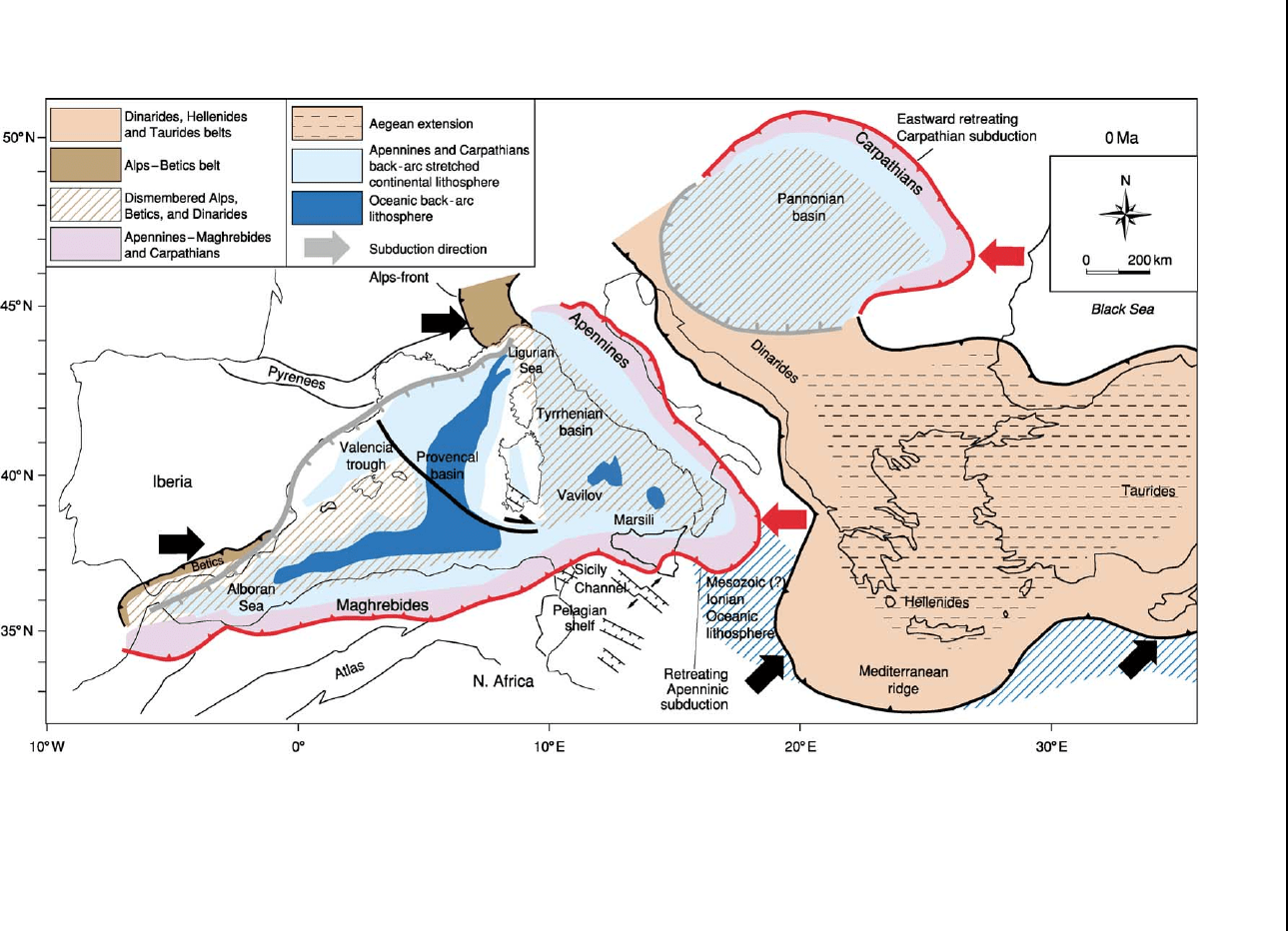
Figure 1 Present geodynamic framework. There are four subduction zones with variable active rates in the Mediterranean realm: the westwards-directed Apennines–Maghrebides; the
westwards-directed Carpathians; the north-eastwards-directed Dinarides–Hellenides–Taurides; and the south-eastwards-directed Alps. The Apennines–Maghrebides subduction-related
back-arc basin of the western Mediterranean stretched and scattered into segmented basins most of the products of the Alps–Betics orogen.
EUROPE/Mediterranean Tectonics 137
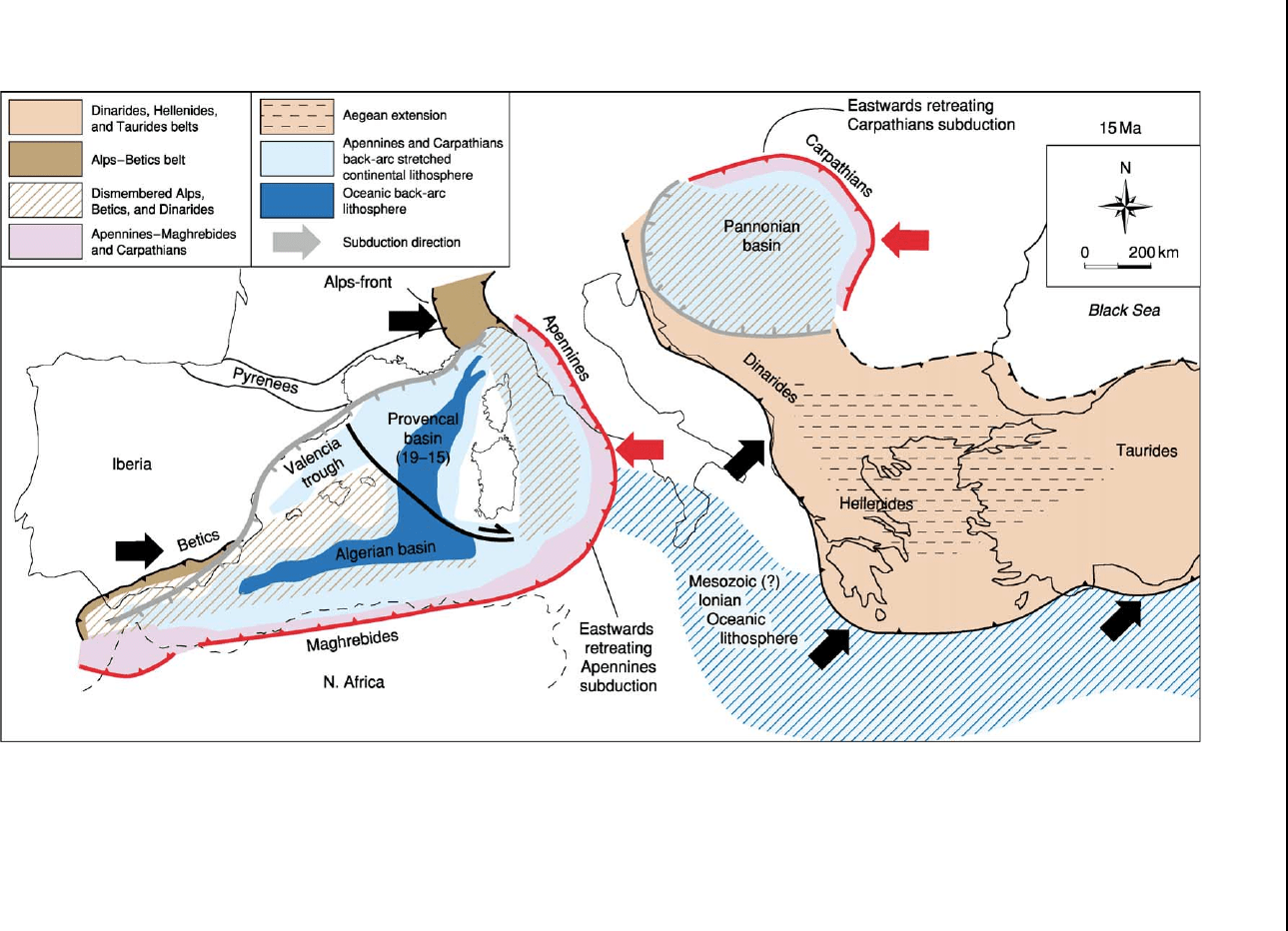
Figure 2 Palaeogeodynamics at about 15 Ma. Note the ‘eastward’ vergence of both the Apennines–Maghrebides trench and the back-arc extensional wave. The Liguro-Provenc¸ al basin,
the Valencia trough, and the North Algerian basin were almost completely opened at 10 Ma. The Dinarides subduction slowed down, owing to the presence of the thick Adriatic continental
lithosphere to the west, whereas to the south the Hellenic subduction was very lively owing to the presence in the footwall plate of the Ionian oceanic lithosphere. The Carpathians migrated
eastwards, generating the Pannonian back-arc basin, with kinematics similar to those of the Apennines. Provencal basin (19–15) ¼ Age of the oceanic crust.
138 EUROPE/Mediterranean Tectonics
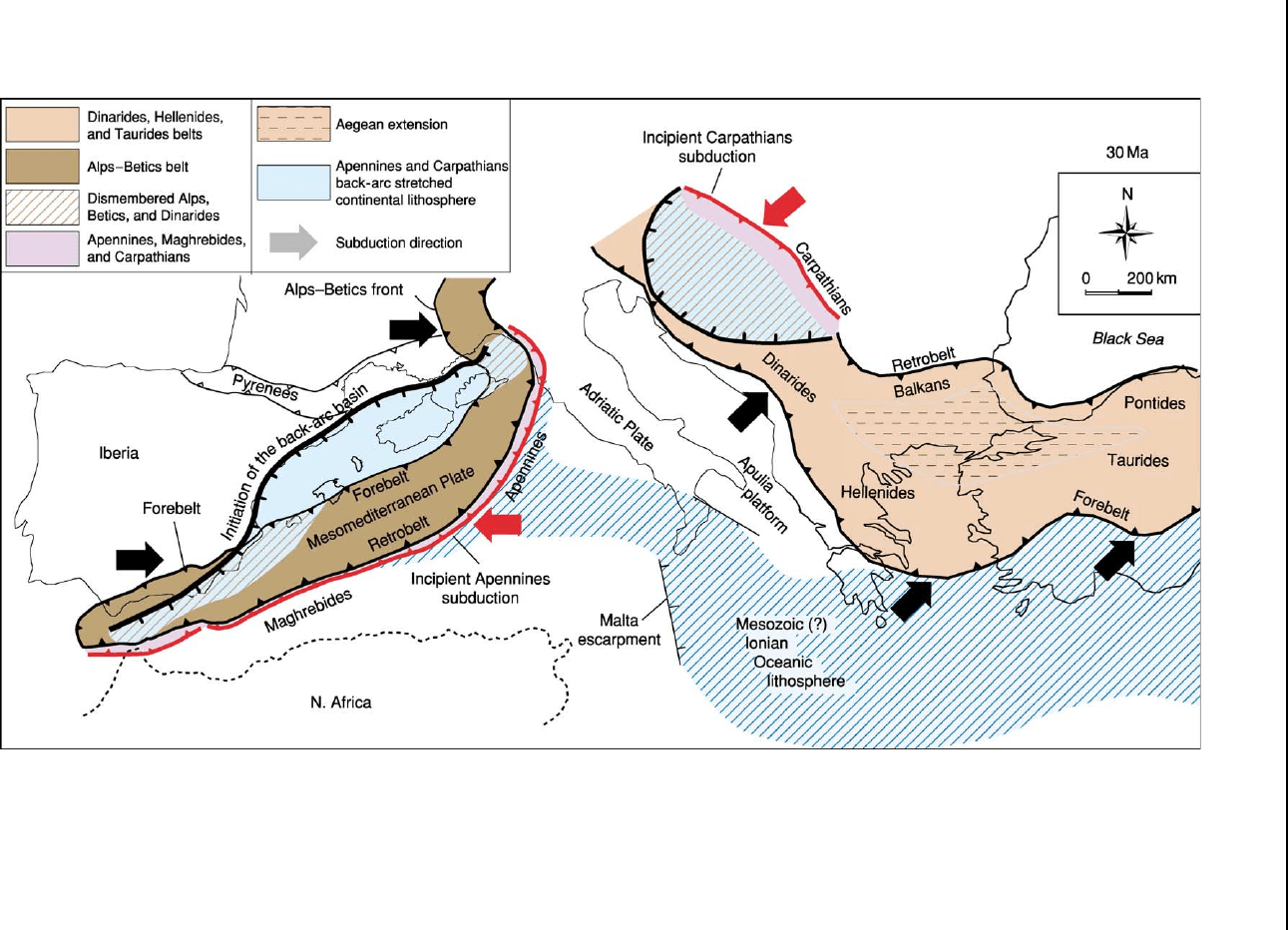
Figure 3 Palaeogeodynamics at about 30 Ma. The locations of the subduction zones were controlled by the Mesozoic palaeogeography. The Alps–Betics formed along the
south-eastwards-dipping subduction of Europe and Iberia underneath the Adriatic and Mesomediterranean plates. The Apennines developed along the Alps–Betics retrobelt to the east,
in which oceanic or thinned pre-existing continental lithosphere was present. Similarly, the Carpathians started to develop along the Dinarides retrobelt (i.e. the Balkans). The fronts of the
Alps–Betics orogen were cross-cut by the Apennines-related subduction back-arc extension.
EUROPE/Mediterranean Tectonics 139
